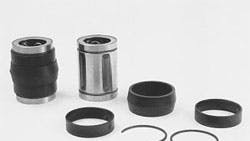Q: In our application, vibration and misalignment are facts of life. And so is early failure of the linear bearing. We can’t eliminate the disturbances, but what can we do?
A: The answer is probably a resilientmounted linear bearing. This is a linear bearing with a band of elastomeric material mounted on the outside of the fixeddiameter bearing. Keep in mind that this solution is used only with fixed-diameter bearings.
The band is designed so it can be easily installed in a housing. But once installed, the elastomer sets or locks in position. The bearing becomes permanently mounted and cannot be removed without mechanical pressure. Resiliency of the band material provides a permanent, self-aligning support for the bearing.
The bearing must be aligned as accurately as possible after it is pushed into the housing bore; once set, the elastomer will self-align only within a few degrees.
Self-alignment of these bearings provides several advantages, including:
• Uniform distribution of load over the entire length of the load-carrying rolling elements.
• Compensation for slight housing bore and parallel-shaft alignment errors.
• Reduction of shaft straightness requirement and noise by insulating the bearing from metal-to-metal contact with the housing.
• Elimination of close-tolerance and smooth-finish requirements on housing bores, and allowance for moderate shaft deflection.
Another option is to place vibration damping pads between the housing and the base or the carriage.
Q: After routine bearing maintenance and re-installation of bearings in a precision worktable, we’ve had shaft grooving and rough, nonuniform table motion. Any suggestions?
A: I’ll bet you are using preloaded linear bearings because of the precision required in your application. If so, the symptoms you describe probably result from excessive preload. It will increase friction and shorten bearing life. A bearing can be preloaded by using an adjustable- diameter bearing in an adjustable- diameter housing. An adjustable housing is usually split and fitted with an adjusting screw to change its bore.
When installed in an adjustable housing, the outer surfaces of the free-floating bearing plates seat against the housing bore. As you adjust the housing to a small diameter, the plates and balls move inward toward the shaft until you get optimum zero-clearance or slight preload.
The easiest way to adjust the bearing and housing for zero-clearance or slight preload is to feel the freedom of rotation between bearing and shaft. First, loosen the housing to permit free rotation of the shaft. Then, gradually close in the housing (and bearing) until it starts to grip the shaft. As soon as you feel a slight increase in torque needed to turn the shaft, stop tightening. This is the point of zeroclearance or slight-preload fit.
In tandem arrangements, adjust one bearing while the other is loose. When one bearing is adjusted, note the positions of the adjusting screws (or, if using a torque wrench, note its reading). Then, loosen this bearing and adjust the second bearing similarly. Then you may return the first bearing to its proper setting.
Another way to get proper preload is to fit a shaft to a linear bearing selectively — but be careful not to preload the installation excessively. When fitting a shaft to a bearing, feel for a slight drag while turning the shaft. If drag is slight and you can overcome it with finger-tip rotation of the shaft, and you can move the shaft linearly with light pressure and no roughness, you’ve set proper preload.
Q: We would like to replace the shafts of a precision machine-tool worktable periodically with shafting we produce ourselves. What are your guidelines?
A: Be careful. There is more to shaft specification than meets the eye. Besides the obvious requirements of hardness and diameter tolerance, there are the stringent requirements for circularity, taper, concavity, convexity, and straightness. If these are not held closely, bearing balls will be unequally loaded causing premature failure. Therefore, be warned: It’s usually best to leave this to the experts.
But if you feel confident enough to do it yourself, here are some guidelines. To provide smooth operation and the required precision, shafting should be smooth, round, and straight. Roundness should be to 0.0001 in.; straightness, within 0.001 to 0.002 in./ft. To assure long service for all but lightly loaded applications, shaft hardness should be 60 to 65 Rc to adequate depth.
Be careful not to exceed the maximum permissible diameter with shafting you produce yourself. Because of the tolerance on the bore of linear bearings, the shaft diameter should always be smaller than the nominal dimension. For example, if the bore of a 1/2-in. bearing is 0.5000 in. 10.0000 20.0005 in., shaft diameter should not exceed 0.4990 in., because the bore can go as small as 0.4995 in., and 0.0005-in. operating clearance is usually recommended.
Next: Electric-motor bearings.
